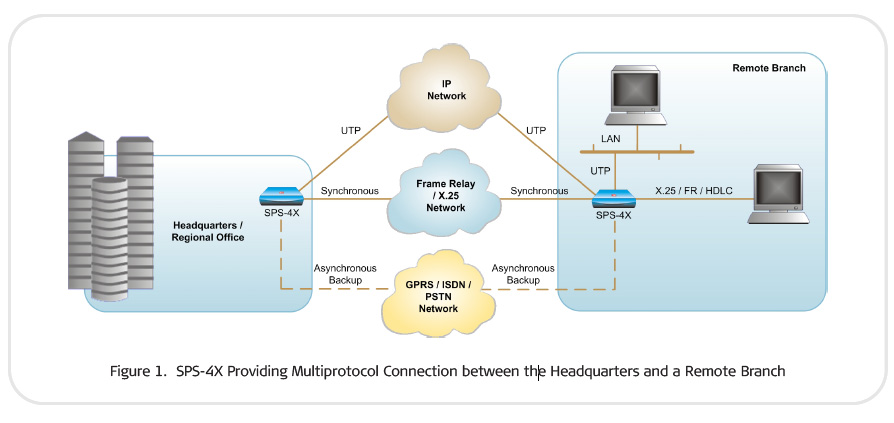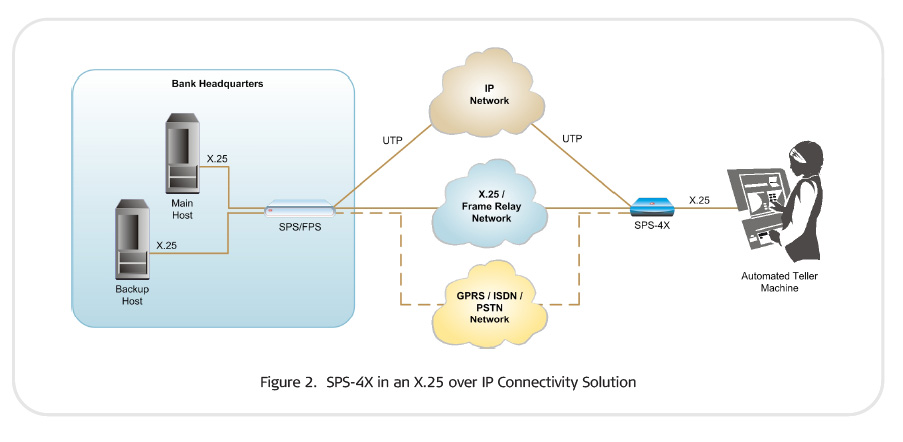




SPS-4X Multiprotocol Packet Switch

SPS-4X is a multilink packet switch, providing multiprotocol connection between the enterprise headquarters and
remote branches. The RAD SPS-4X carries the X.25, Frame Relay and HDLC legacy data over next-generation
packet-switched networks, using edge-to-edge pseudowire (PW) connections. In addition to pseudowire connectivity,
X.25 traffic can be carried over TCP/IP connections instead of over LAPB (Link Access Procedure, Balanced) connections.
While retaining the functionality of the SPS product family, SPS-4X supports an asynchronous backup channel over
PSTN, ISDN and GPRS networks. The SPS-4X includes two Ethernet (UTP), one ISDN and three serial link interfaces.
PSEUDOWIRE CONNECTIVITY with SPS-4X Uniquely-formatted Ethernet packets are sent and received by SPS-4X in order to
transport legacy protocols (X.25, HDLC, Frame Relay) over packet-switched networks.
RAD SPS-4X X.25 AND XOT CONNECTIVITY
The RAD SPS-4X handles both mandatory and additional ITU X.25 facilities. X.25-configured links support permanent
virtual circuits (PVCs), switched virtual circuits (SVCs) and multicasting. Dial-up X.25 links are supported via a
dial-up modem, controlled by a DTR signal or V.25 bis commands. Up to 16 XOT (X.25 over TCP/IP) sessions
are supported over an IP network. HDLC CONNECTIVITY Each port can be programmed to operate
in transparent HDLC mode for connecting bridges, routers and other HDLC communication devices over X.25 or
Frame Relay networks. The HDLC protocol is encapsulated over X.25, Frame Relay or
pseudowire connections, providing transparent end-to-end operation.

ASYNCHRONOUS ACCESS with SPS-4X
All asynchronous channels function according to the X.3, X.28 and X.29 profiles, at traffic speeds of up to
115.2 kbps. Asynchronous traffic can be packetized directly over a Frame Relay network, or over an X.25 network. All
channels are configured and monitored by the SPS-4X management agent. Each SPS-4X port can be configured to PPP
(point-to-point) mode, operating at data rates of up to 115.2 kbps. IP PAD facilities allow straightforward
migration of terminal/server applications to an IP environment, while improving its
durability at the same time.
RAD SPS-4X IP ROUTING
SPS-4X routes IP datagrams over Ethernet, or PPP links and over Frame Relay networks
(according to RFC 1490), or over X.25 networks (according to RFC 1356). SPS-4X supports RIP1, RIP2 and triggered
acknowledgment RIP messages (according to RFC 1058, 1723 and 1724). The RIP provides trouble-free IP connection while
minimizing IP user configuration. The triggered RIP enables reduction of the overhead associated with the RIP
mechanism, by minimizing the number of periodic messages sent.
FRAME RELAY ACCESS with RAD SPS-4X
SPS-4X provides access and switching to public or private Frame Relay networks, and consolidates asynchronous, HDLC, IP
and X.25 traffic over the Frame Relay network. As a Frame Relay switch, SPS-4X integrates DLCIs from several sources into
a single port. It also supports BECN/FECN signaling for avoiding congestion. A unique funneling mechanism adjusts
feeder throughput to CIR levels. The Frame Relay multicasting feature (complies with FRF-7) enables multicasting
frames from one DLCI onto several DLCIs. This feature supports one-way, two-way and broadcast communication options.
SPS-4X ISDN LINKS
SPS-4X allows PPP/FR/X.25 data to be transmitted over ISDN media, which features a data rate of up to 192 kbps.
The unit's ISDN port supports one ISDN link.
MANAGEMENT OPTIONS with SPS-4X
A management station can be connected to SPS-4X using LAN or point-to-point connection.
The unit can also be managed out-of-band using an ASCII-based terminal connected
to the RS-232 port.
SPS-4X has a built-in Telnet client/server to support terminal/server applications.
After a network recovery, SPS-4X automatically synchronizes itself with the main facility link.

RAD SPS-4X product data sheet (pdf)